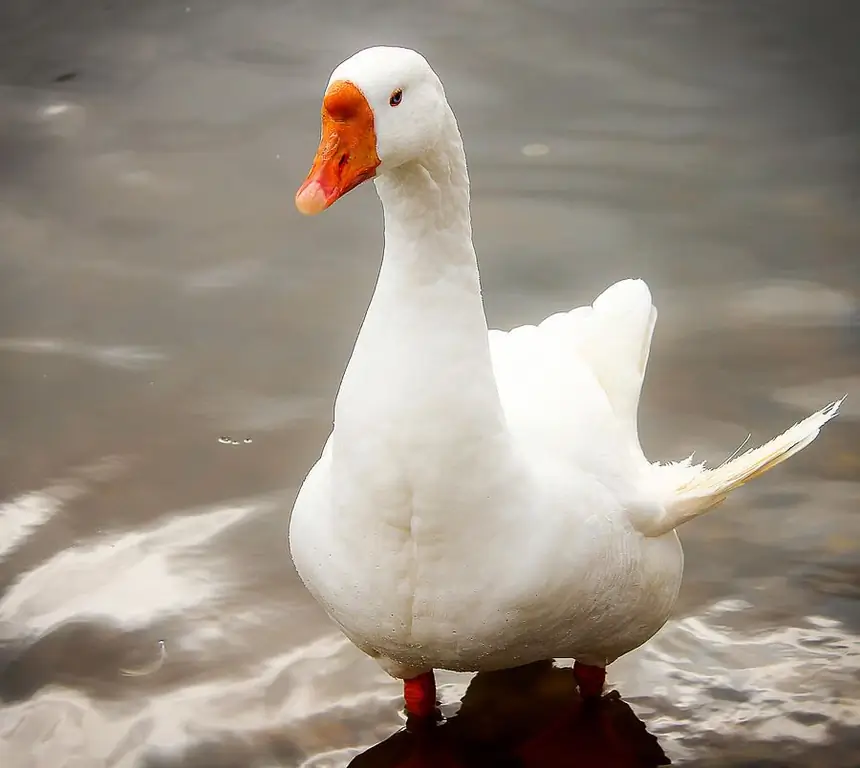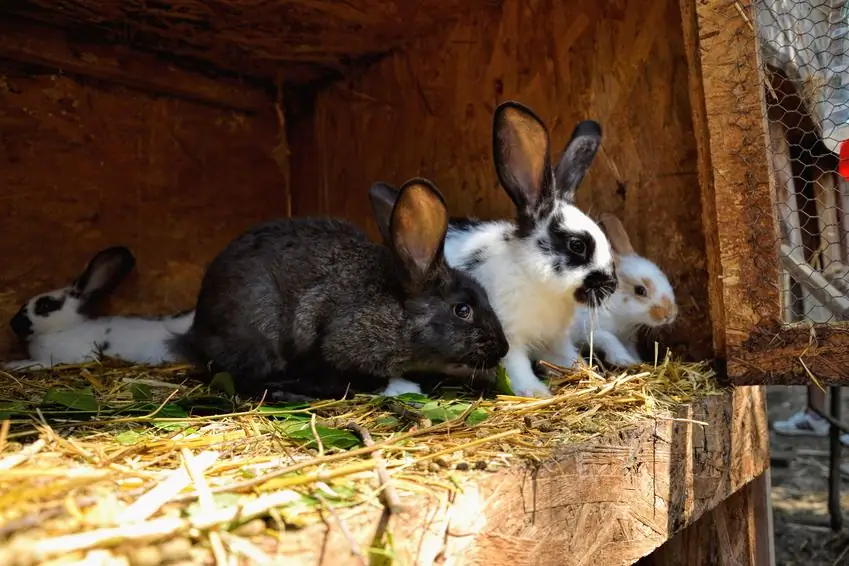2025 Author: Howard Calhoun | [email protected]. Last modified: 2025-01-24 13:10:41
Recently, breeders have bred many new breeds of geese. For the most part, such a bird is characterized by unpretentious care and excellent productivity. However, there are several older breeds of geese that are also very popular with farmers. Such farm animals are often able to show simply outstanding results in terms of weight gain. For example, in the Nizhny Novgorod region, Chuvashia and Mordovia, the old highly productive breed of Arzamas geese is quite widespread.
A bit of history
These geese were bred in the city of Arzamas back in the 17th century by the method of folk selection. Initially, the breed was used exclusively as a fighting dog. For goose competitions, the peasants specially selected the largest and most active individuals. Later, Arzamas geese were kept on farms mainly for meat. Since the 19th century in battles, such a bird was no longer used. By this time, the breed had become exclusively meat.

General description of Arzamas geese
What breeds were once parental for this bird,unfortunately not known for sure. No records of this have survived. However, judging by the exterior, these geese were most likely bred on the basis of the Tula breed. Such a bird in the old days was very popular among the peasants. Tula geese were bred on the territory of the present Nizhny Novgorod region everywhere. Like this parent breed, the Arzamas bird has three main types of exterior:
- with a slightly concave beak;
- direct;
- convex.
Also, the main features of this bird are:
- powerful meat physique;
- bulging chest;
- straight back;
- wide wings covering the lower back.
The head of these geese is short, the forehead is wide, and the beak is less powerful than that of the representatives of the Tula breed, but still quite thick. The legs of the Arzamas bird are short, yellow, with straight toes.

The plumage of the geese of this breed is dense and dense. The color of the Arzamas bird is most often white. However, the breed standards also allow gray and cream feathers.
Economic signs
Grow these geese and white, and gray, and cream is actually very large. At the same time, they do not consume too much feed. That is, this breed, among other things, is also very economical. Also, the advantages of this bird include, of course, precocity.
The weight of male geese of this breed can reach up to 5, and sometimes7 kg. The body weight of geese is slightly lower. Arzamas females weigh between 5-5.8 kg. The meat of representatives of this breed is very tasty, tender and juicy. At the same time, it is not too greasy and is great for both first and second courses.
Arzamas geese do not carry very many eggs - an average of about 20 pieces. for the season. But at the same time, the females of this breed are very good mothers. They hatch and nurse goslings on their own.

Among the advantages of the Arzamas poultry, farmers, among other things, include unpretentiousness in feed. In the summer, these geese are simply driven out to pasture for the whole day. The Arzamas bird shows good productivity results even with a small amount of concentrates in the diet. However, if you finish off more grains in the menu of such geese, they will begin to grow at an accelerated pace.
Reproduction
For beginners, breeding geese can, of course, be quite difficult. And for beginners, experienced farmers recommend starting the Arzamas bird at first. At the moment, this breed is one of the most unpretentious in the world. Caring for this bird is a completely simple procedure. And, most likely, a beginner breeding herd will not have to make any special efforts to replenish the herd.
Goose of this breed do not carry too many eggs, but their fertility is always good. In most cases, this figure reaches 85%. Considering that Arzamas females care for their offspring diligently,the herd of such geese on the farm is usually replenished very quickly. If desired, the egg of this bird, of course, can be incubated.
As male sires in the herd of Arzamas geese, individuals are selected whose weight is 10% higher than the average parameters in the livestock. At the same time, 2-3 females are left for one goose. The Arzamas bird was once bred as a fighting bird. But over time, her character became still not so aggressive. Arzamas goose families in the courtyard are allowed to be kept together. However, in the event that the males show aggression towards each other, they, along with the females, should still be seated in different compartments.

Ganders of this breed are usually used as producers for no longer than 4 years. Then the male is changed to a new one. It is impossible to keep the same producer on the farm for too long. This will necessarily lead to a decrease in the quality of the offspring and, accordingly, the productivity of the entire livestock.
Egg-laying
Arzamas gray, cream and white geese rush from the end of winter to the beginning of May. At this time, nests of at least 70x70 cm in size should be placed in the barn for such a bird. The number of the latter should be chosen at the rate of 1 pc. for 2-3 females. To install nests for geese of this breed, like any other, you need in a dark, warm place.
Feeding Features
In the summer, as already mentioned, Arzamas geese are usually driven out to pastures. Also during this period they are given some concentrates, vegetables, fruits. A very good help in the economy in terms offeeding such a bird will be a nearby pond. If desired, on the site you can make a small artificial pond with your own hands. In any case, aquatic vegetation is very useful food for geese.
In winter, such a bird is fed with alfalfa and clover hay mowed during the flowering period. Also, boiled corn and potatoes are introduced into the diet of geese in the cold season. In addition, in winter, the Arzamas bird can be fed with wheat and bran. Very often, various kinds of berry crops are included in the diet of such geese - mountain ash, wild rose, viburnum.

What should the room be like
A barn for Arzamas geese, like for any other, should be built in such a way that it turns out to be light, dry and warm. Before starting the young stock, the poultry house must be prepared by treating it with lime mortar. Thus, the barn is disinfected from various pathogens and parasites.
Litter for Arzamas geese in a poultry house can be used from sawdust, straw or sunflower husks. The shed itself should be built in such a way that one adult individual in it has at least 1 m22 area.

Of course, the house for Arzamas geese should be insulated. This bird is practically not afraid of cold. However, it is still impossible to allow the air temperature in the barn for such geese to drop below 0 ° C in the winter season. Next to the poultry house, among other things, it is worth equipping a spacious paddock. Winter geese in the afternoonmust be let out from time to time.
The barn itself for this bird should be built in such a way that drafts do not form inside it. Otherwise, the geese of the Arzamas breed, despite the fact that they are distinguished by endurance, will certainly begin to catch a cold. As a result, the herd may even increase the drop rate.

Slaughter time
Growing geese as a business is usually quite profitable. Farmers keep such a bird, of course, mainly for meat. And representatives of the precocious Arzamas breed can bring their owner in this regard, of course, a very good income. Even on the most inexpensive feed, such a bird grows very quickly.
Arzamas geese are gaining weight very quickly. Their body weight by two months is already about 3.4 kg. This bird is usually slaughtered at the age of 2.5-4 months. It is not recommended to keep such geese, as well as representatives of many other breeds, for longer. After 3-4 months, this bird dramatically reduces its weight gain. At the same time, geese begin to consume more feed. In addition, the carcasses of a young Arzamas bird look more accurate than those of an old one. Of course, the meat of 3-month-old goslings will be more tender and juicy than, for example, 6-9-month-old ones.
Recommended:
Levkoy: growing from seeds, planting and care, growing features

The most famous flower of the levka, grown from seeds in our gardens, has the scientific name Matthiola incana. The plant was first described by the Italian botanist Pietro Mattiole around the middle of the 16th century. There are variants of annual and perennial plants. Height - between 20 and 80 cm. In this case, the plant can have both single stems and be a shrub type. The root is shallow. It is slightly branching in the plant
Growing geese at home for meat: technology, breed selection, feeding

The concept of poultry farming includes not only the cultivation of chickens. Geese make up worthy competition for restless laying hens. In terms of population, they rank second. Growing geese at home for meat is not an easy job, and the eggs they carry can replace chicken
Italian geese: description of the species, features of care, reproduction, characteristic features, rules of keeping and profitability

Geese breeding is a great way to earn money for a farmer. They are unpretentious in care, quickly gain weight and are in demand among the population. White Italian geese will not only bring a good income, but also decorate the courtyard with their appearance. Birds adapt well to different conditions of detention, they can be bred in any climatic zone. Italian geese - a godsend for an enterprising farmer
Chinese geese: photo and description of the breed

One of the types of domestic birds are Chinese geese. This breed was first domesticated in Manchuria. This is a small province in northeast China, which is how the geese get their name. In Europe, Chinese geese began to be bred in the eighteenth century
Rabbits of the Strokach breed: description of the species, features of care, reproduction, characteristic features of the breed and rules of keeping

If someone has a goal to breed rabbits of the Strokach breed, then it is necessary to remember that it is best to have only the strongest and best individuals of the German breed. When grown at home, many farmers do not always succeed in breeding a pure breed, as some individuals are variegated or get sick

